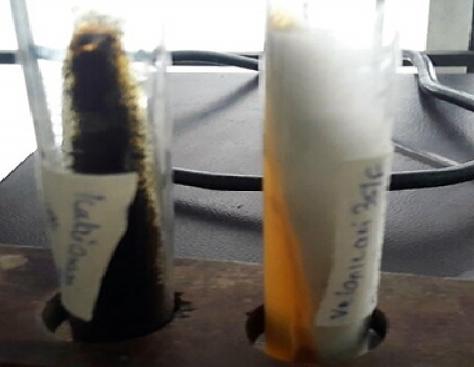
A Clinicomycological Analysis of Predisposing Factors and Various Fungal Agents Involved in Clinically Suspected Cases of Otomycosis
Abstract
Otomycosis is a common infective condition of the ear
caused by fungi. It has a worldwide distribution yet its
prevalence is greater in the tropical and subtropical
region. The aim of the study was to determine the common
predisposing factors and the various fungal agents involved
in otomycosis. The study group included patients attending
the ENT OPD at Government Kilpauk medical college and
hospital. Samples were collected from 200 clinically
suspected cases of otomycosis between January 2016 and
January 2017 and were subjected to mycological analysis.
Of the 200 clinical samples, otomycosis was confirmed in
69%. The commonest symptoms were otalgia and aural
pruritus. Use of eardrops followed by use of oil in the ear
were the common predisposing factors. Aspergillus niger
was the commonly associated fungal species followed by
Candida albicans. The study revealed a variety of fungal
agents causing otomycosis stressing the need for a proper
mycological evaluation while treating otomycosis.
Full Text:
PDFReferences
Aneja K R Sharma C, Joshi R, Fungal infection of the ear;
A common problem in the north eastern part of Haryana,
Internatonal Journal of Paediatric Otorhinolaryngology
;74:604-607.
Fasunla J, Ibekwe T, Onakoya P. Otomycosis in western
Nigeria. Mycoses 2008; 51: 67–70
Kaur R, MittalN, KakkarM, Aggarwal A, Mathur K.
Otomycosis a clinicomycologic study. Ear Nose Throat J
;79: 606-609
Gokhale SK, Suligavi SS, BaragundiM, Anushka D,
Manjula R. Otomycosis-AClinicoMycological Study. Int J
Med Health Sci 2013;2: 218-223.
Prasad SC, Kotigadde S, Manisha S et al. Primary
Otomycosis in the Indian Subcontinent: Predisposing
Factors, Microbiology and Classification. International J of
Microbiology 2014;
Pradhan B,Tuladhar NR and AmatyaRM.Prevalence of
Otomycosis in outpatient department,department of
Otolaryngology in Tribhuvan university Teaching Hospital,
Kathmandu, Nepal. Ann OtolRhinolLaryngol 2003;52: 76-80.
Panchal P, Pethani J, Patel D Rathod S and Shah P.
Analysis of various fungal agents in clinically suspected
cases of Otomycosis.Indian J of Basic and Applied Medical
Research 2013;2(8): 865-869.
Martin AM, Canut A, Munoz S, PescadorC, Gomez JL.
Otomycosis: presentation of 15 cases. EnfermedadesInfecciosasy
y MicrobiologíaClínica1989;7:248-251.
Paulose KO, Al Khalifa S, Shenoy P, Sharma RK: Mycotic
infection of the ear (otomycosis): a prospective study. J
LaryngolOtol1989;103:30-35
B Barati, S A R Okhovvat, A Goljanian, M R
Omrani ,Department of Otolaryngology, Isfahan University of
Medical Sciences, Isfahan, Iran- Otomycosis in Central Iran:
A Clinical and Mycological Study,IRCMJ 2011;13:12 p
-876.
Kumar A. Fungal spectrum in otomycosis patients. JK
Science 2005;7:15p2-5
Pontes ZB, Silva AD, Lima E, Guerra M, Oliviera N,
Carvalho M, Guerra FS. Otomycosis: a retrospective study.
Braz J Otorhinolaryngol2009;75:3p67-70
Stern JC, Lucente FE. Otomycosis. Ear Nose Throat J
;67: 80p4–10
S. K. Jain and S. C. Agrawal, “Sporostatic effect of some
oils against fungi causing otomycosis,” Indian Journal of
Medical Sciences,vol.46,no.1,pp.1–6,1992
M.M.Yehia,H.M.Al-Habib,andN.M.Shehab,“Otomycosis:
acommonprobleminNorthIraq,” Journal of Laryngologyand
Otology,vol.104,no.5,pp.387–389,1990.
X.Jia,Q.Liang,F.Chi,andW.Cao,“OtomycosisinShanghai:
aetiology, clinical features and therapy,” Mycoses, vol. 55, pp.
–409,2012.
J. Chander, S. Maini, S. Subrahmanyan, and A. Handa,
“Otomycosisa—a clinico-mycological study and efficacy of
mercurochromeinitstreatment,”Mycopathologia,vol.135,no.
,pp.9–12,1996.
Refbacks
- There are currently no refbacks.

This work is licensed under a Creative Commons Attribution-NoDerivatives 4.0 International License.
An initiative of The Tamil Nadu Dr M.G.R. Medical University